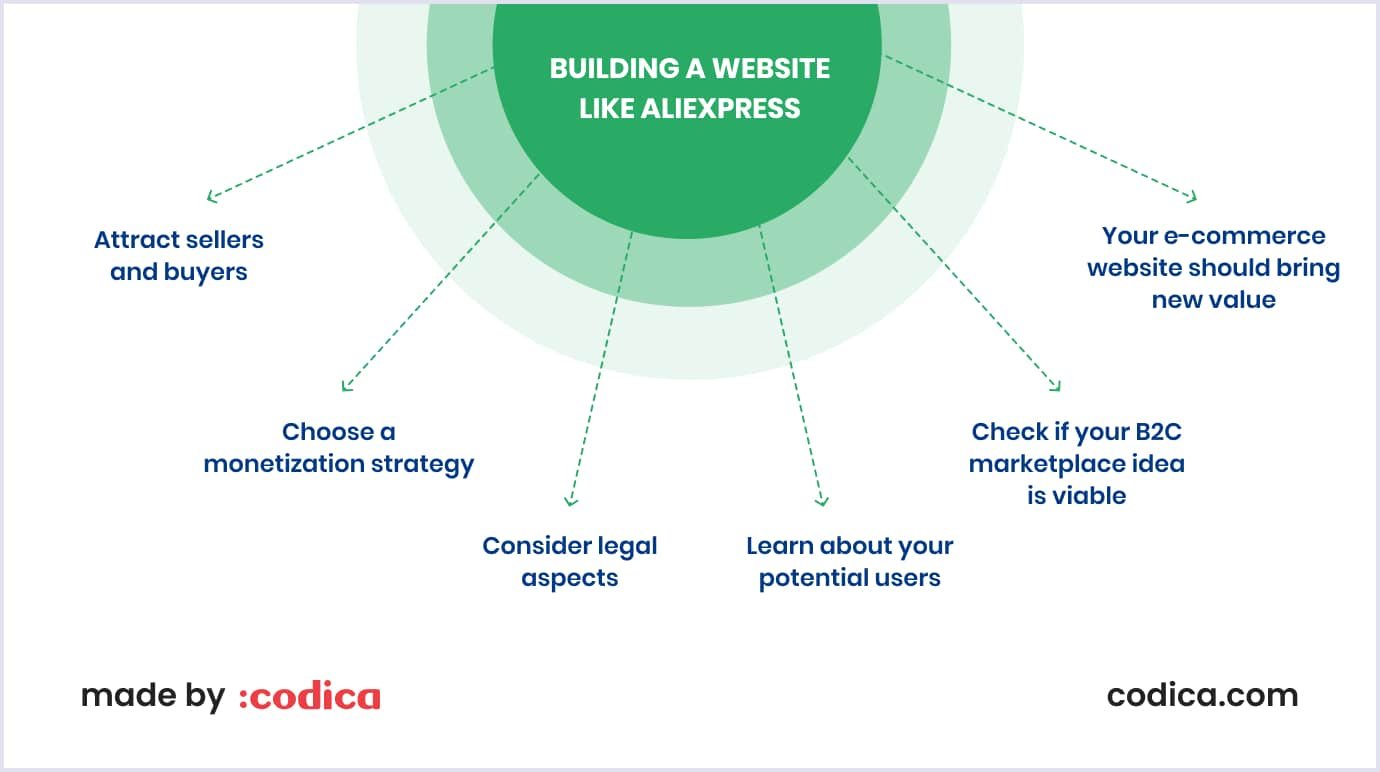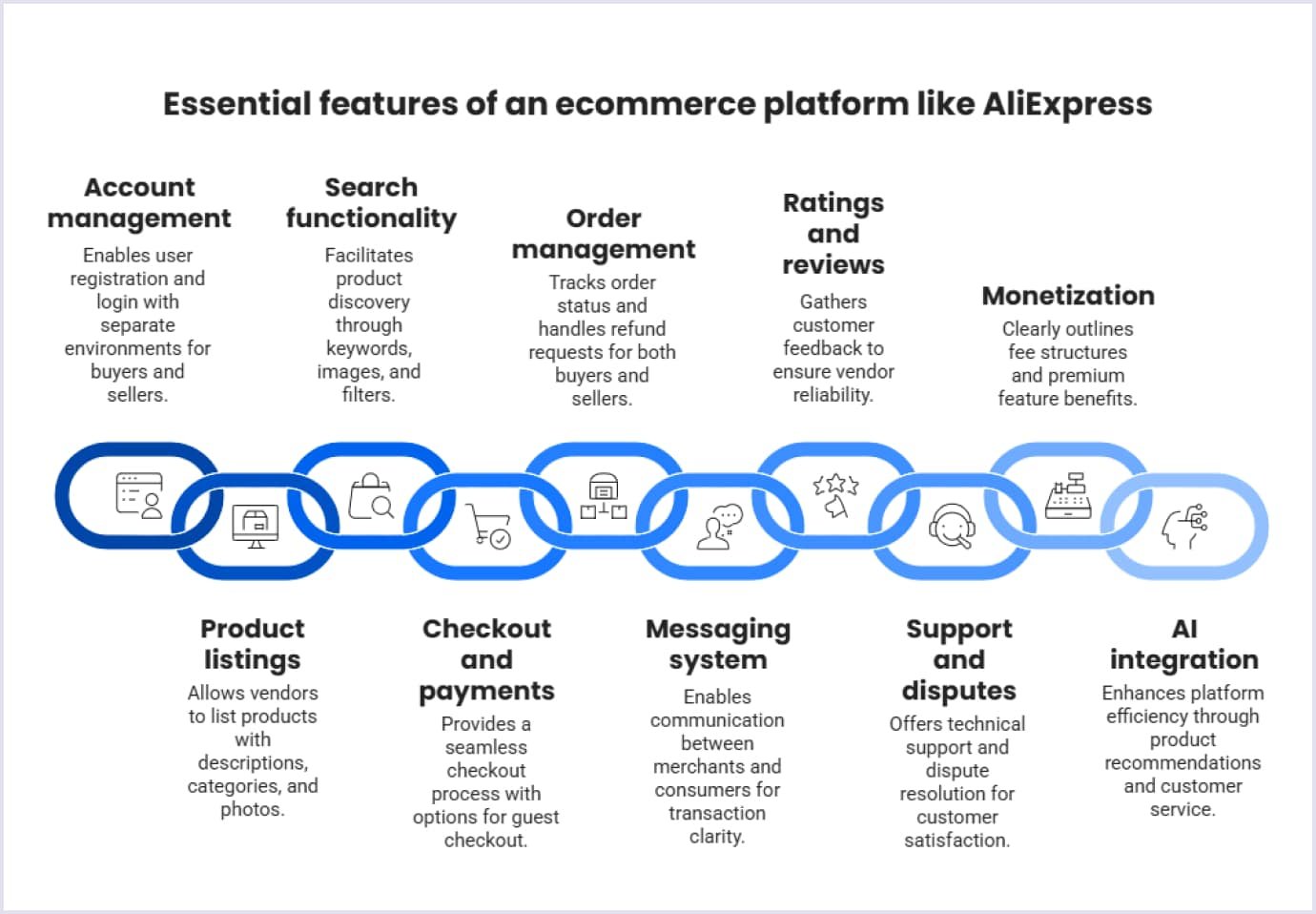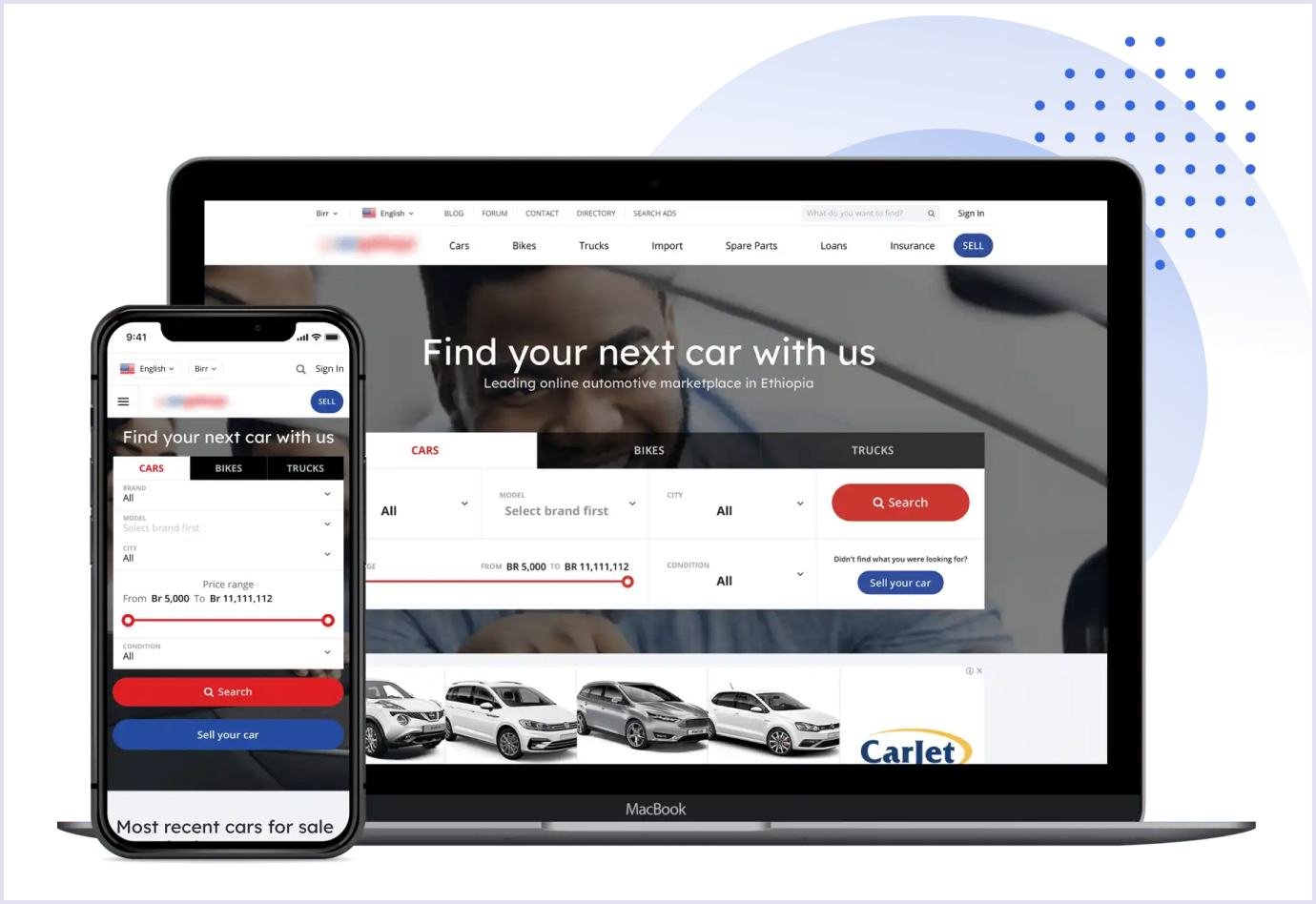When the AliExpress platform started, it offered to sell and buy online for business entities. Later, it expanded its services. Now, it’s a large online commerce portal connecting China and the world. So, AliExpress’ experience serves as an inspiring story for companies looking for similar success.
Why is this platform so popular? The answer is quite simple: people like to shop fast and in an easy way. That’s why online shopping is a profitable way to make money. At the same time, the market is saturated so much that today, it’s not enough to build a marketplace. Therefore, your website, like AliExpress, should be a game-changer in order to prosper in the world of ecommerce.
This article reveals vital aspects of how AliExpress succeeded and how to create a website like AliExpress.
Overview of AliExpress
In general, AliExpress is a B2C marketplace founded in 2010 and owned by Alibaba Group. Alibaba is based in Hangzhou, China, focusing on major wholesale market players and transactions. Meanwhile, AliExpress was created to support small Chinese businesses. The founders aimed to expand Chinese retailers’ businesses worldwide. This is the key difference between Alibaba and AliExpress.
Below, you can see the comparison of the two companies and how they differ.
| Difference between Alibaba and AliExpress | ||
| Company | Alibaba | AliExpress |
| Year of foundation | 1999 | 2010 |
| Business model | Business-to-business (B2B) | Business to Business (B2B) and Business to Customers (B2C) |
| Monetization model | Membership fees, commission on transactions, advertisements | Seller fees, commission on transactions, advertisements, additional services like logistics support |
| Minimum amount per order | Sets a minimum order quantity and requirements on the product amount that a buyer can make | No fixed amount of products per order |
| Pricing | Prices may vary for the same product | Prices are set with no option for change |
| Checking the product quality | A buyer can check the quality of products before purchasing | A buyer can check the quality of products after receipt |
| Custom production | Suppliers may offer customized versions of products | Suppliers offer standard versions of products |
| Shipping service | Agreed between seller and buyer | Arranged by seller |
| Payments | Credit/debit cards, PayPal, Apple Pay, Google Pay, bank transfers | Credit/debit cards, PayPal, Alipay, bank transfers |
How does AliExpress work?
As we already mentioned, the platform is a multi-vendor B2C marketplace that connects buyers and sellers.
Therefore, the custom enterprise software solution helps deliver products from Chinese retail sellers to shoppers in many countries. It uses a trading system that handles complex operations to deliver high-level service to customers.
Let’s see how the portal works and its pros and cons.
Pros of the platform
The website facilitates user experience (UX), both for buyers and sellers. Consumers benefit from an opportunity to get cheap products fast. Vendors enjoy going through the simple process of selling items.
For example, the website helps novice dropshippers to start an online business easily. Usually, entrepreneurs need to submit many documents to start a business. This process is time-consuming and challenging. So, AliExpress simplified registration for new sellers. They only need to sign up on the retail platform.
In addition to dropshipping, the enterprise suggests an affiliate program aimed at boosting the platform’s sales. Vendors can join the affiliate program directly on the website, and then the marketplace provides sellers with a unique link to particular products on AliExpress. Thus, the affiliate seller earns an extra commission of 5% to 9% for qualifying sales.
Other pros of the AliExpress platform are as follows:
- Access in different languages;
- Reviews with photos;
- Linking sellers and shoppers from many countries;
- Moderate commissions and fees;
- Various options for online payments;
- Direct delivery of goods.
Cons of the platform
On the other hand, the enterprise has its disadvantages:
- Significant variations in quality;
- Long delivery times;
- Sometimes, it isn’t easy to return products due to sales from international sellers.
Despite these drawbacks, the retail service platform is supportive of consumers. In case of a misunderstanding, a seller would ship another product. Thus, the sellers do their best to avoid disputes with buyers.
How does AliExpress make money?
As you plan to run a website like Alibaba or AliExpress, you must decide how your portal will make money. The monetization strategy is essential as it helps keep users loyal to your business.
Though AliExpress suggests free registration and supports dropshipping services, they take other fees.
- The company charges from 5% to 8% for each seller’s transaction.
- Also, it raises payment processing fees.
- Moreover, the business made around $263 million from advertisements in 2023 in Europe alone.
- An affiliate program brings revenue to affiliates, and AliExpress benefits from relevant sales.
AliExpress offers discounts during big sales, like Bachelor's Day, the AliExpress Birthday sale, and seasonal sales. New users also have discounts, like a New User Coupon.
Success factors of the Chinese B2C marketplace
The enterprise has found a way that giants failed to reach. The critical aspect that brought success to AliExpress was Jack Ma’s (co-founder of Alibaba Group) knowledge of China’s market peculiarities. He understood the potential of the idea of delivering cheap products fast around this vast country.
Local merchants’ and buyers’ needs
Companies like eBay and Amazon failed to enter the Chinese market because of missing crucial points. For example, many people in China are retailers and manufacturers, and they need their operations to move fast.
Alibaba Group understood this and incorporated relevant services into its business. Now, Alibaba Group and JD.com, Alibaba’s main competitor, hold a significant market share in China.
Local payment system
Ecommerce companies have tried to enter China’s market by offering PayPal payments. This tool was not convenient in the Chinese market due to China’s currency conversion and governmental restrictions. There is also a demand in China for paying with online wallets.
So, Alibaba Group presented a unique payment method. The holding created Alipay, which is safe and straightforward to use in China. The system uses the escrow method, meaning a seller receives money only after a shopper confirms the product's quality.
AliExpress mobile apps
Smartphone usage statistics show that people look up the products with these devices 4.2x more compared to using the websites. The company created smartphone apps for iOS and Android, allowing users to buy and manage their accounts directly from the apps. The apps offer to select products and make orders just like on the AliExpress website.
Logistics
A crucial aspect of a successful e-commerce website is smooth logistics with the delivery of products in the shortest time. So, AliExpress partnered with the Cainiao network that offers logistics services. Currently, it takes 10-12 days to deliver products to Spain, France, and Brazil, and 5 days to South Korea.
In addition, the enterprise partnered with many logistics companies. So, this B2C portal saved on investing in partners' expensive fleets for shipping.
Workflow automation
AliExpress uses 800 robots in the warehouse, which automate many processes and save time. The enterprise also operates automated sorting centers and 20,000 self-pickup centers, shortening the cross-border delivery time.
Further reading: 10 Things to Know Before Building a B2C Marketplace Platform
The benefits of creating a store similar to AliExpress
Alibaba Group's ecommerce retail division saw robust growth, bringing in $5.17 billion in 2024. This profit came mainly from retail commerce platforms, including AliExpress. Let’s see what helps this business thrive and what benefits a similar website could bring.
- No costs for keeping stock. The enterprise acts as an intermediary between buyers and sellers, providing safe and quick goods turnover. You don’t need an inventory of goods. So, a website similar to AliExpress saves you costs that could be needed for keeping warehouses.
- Market expansion. The ecommerce market grows with a compound annual growth rate (CAGR) of 8.02%, with wide target audience coverage. It is expected to reach $5.89 trillion by 2029. So, making a website like AliExpress is quite a profitable venture.
- Possibility for quick growth. If you create favorable conditions for buyers and sellers on your portal, they will attract more adopters. AliExpress provided an environment where all sides win.
- Wide audience coverage. AliExpress embraces many merchants and consumers, so a platform similar to AliExpress gives you extensive coverage of the target audience. The wider audience brings higher turnover on your website, thus growing your revenue.
- Easy-to-analyze data. You get ongoing access to the information on users’ behavior. Analyzing it allows you to improve the experience for sellers and consumers. This leads to more significant traffic on your website and better visibility of your business on the web.

Aspects to consider when building an online multi-vendor marketplace
There are certain aspects that are crucial when employing thriving online marketplace development services:

1. Your e-commerce website should bring new value. A mere AliExpress copy is unlikely to bring you profit. There should be something special about your project. Find a niche or approach to connecting buyers and sellers. You can also provide them with unique services or features.
2. Check if your B2C marketplace idea is viable. When you discover your future platform's unique value, check if its services are in demand. So your business will prosper.
3. Learn about your potential users. Discover what products your suppliers and buyers will need. Describe how they will use your site.
4. Consider legal aspects. When you create a website like AliExpress, you might need to submit particular documents and obtain approvals. Also, consider the legal backgrounds of your vendors and shoppers.
5. Choose a monetization strategy. Select the pricing model that brings profit to your marketplace, like AliExpress. You can choose a freemium or commission-based model for your services or win from ads and sponsorships.
6. Attract sellers and buyers. Both sides are important for your B2C marketplace. So, show the value of such platforms to the hardest of them. Use social networks or partner with prominent people to promote your retail platform. When the hardest side’s activity is on the rise, the other party will be eager to join your AliExpress clone website, too.
Core features for an ecommerce platform like AliExpress
B2B and B2C marketplaces have similar functionality. They include registration forms, payment methods, ratings, reviews, and recommendations on the goods. This helps shoppers be confident about their purchase, makes them happy with sales, and helps your portal grow.
Let’s see what features you need to create a website like AliExpress.
1. Account creation and login
This feature enables new adopters to register on your AliExpress clone. The registration process must be simple and fast. It encourages people to walk through your e-commerce website and make purchases.
Any user can be a shopper and vendor by creating an account through a straightforward process. The retail platform offers separate environments for both roles. At the same time, it allows easy switching between them without changing an account.
If you are a buyer, you can register your email and start purchases on the portal. If you are a vendor, you need to fill in the details when creating an account.
Further reading: Top 16 Main Online Marketplace Features to Make Buyers Happy
2. Product listings
Product prices at AliExpress must include VAT. A vendor indicates the description, categories, and photos when posting a product listing.
The listings should comply with AliExpress’ requirements. Typically, product listings on an AliExpress clone may include the description, categories, photos, packaging details, shipment conditions, and delivery time.
3. Search
Online marketplaces usually offer search by products. The AliExpress platform also suggests using keywords and photos for search. So, shoppers can upload images to find the desired product. This is helpful when a user does not know the name of a product or is not sure how to explain it, or wants to find the product quickly.
Adding filters and sorting features facilitates the search for a user if there are many options or products in the same category. Such solutions enhance customers’ journey on your website, like AliExpress.
For example, Codica created search filters for an online auto marketplace to help users find a car by price, make, city, and condition. Check the platform flow in the video below.
4. Checkout and payments
The convenient and quick checkout attracts users. Your store, similar to AliExpress, might suggest that your users checkout without registration. At the same time, it is helpful that your portal shows how customers will benefit from becoming portal members.
AliExpress supports many payment methods, including the support of Visa, MasterCard, Western Union, Alipay Balance, and other online payment systems. These solutions allow you to create and make payments by processing many invoices quickly. Quick, easy, and secure payment methods on your multi-vendor marketplace are vital on a website like AliExpress.
Also, the AliExpress clone should clarify the shipment options and costs during the checkout process. This will help users be confident about the payment amount, improving their experience.
Most suppliers offer free shipping for their products. But this means that a shopper might wait for a month or more for the order to arrive. So, AliExpress suggests shoppers tracking numbers and faster shipping for an extra fee.
AliExpress asks consumers to add their shipping address and payment method during the first checkout. The buyer can use these details when making future orders.
5. Order management
This option is important both for buyers and sellers. The features include tracking the order status and sending refund requests. If AliExpress has not processed an order, a shopper can cancel the order. On the other hand, if AliExpress has processed the order, a buyer can send a cancellation request to the vendor.
6. Messaging
Websites like AliExpress use messaging systems to facilitate communication between merchants and consumers. Messaging helps both sides clarify the details of each transaction and allows for quick questions and replies.
Sites like AliExpress typically use built-in chats. In case of disputes, buyers and sellers can use message threads as proof.
7. Ratings and reviews
A website like AliExpress should include the option for getting feedback from customers. These points help shoppers check if the vendor from whom they purchase is reliable. The more reliable you present your site, the more eagerly users will sell and buy on it. There are several ways to check if a merchant is trustworthy on AliExpress:
- Vendor’s membership. The longer the membership, the more reliable the vendor. A shop with a portal membership of a year or more may appear in the buyer’s filter list.
- Sales. The more sales, the more trustworthy the seller is.
- Credits. AliExpress processes customers’ ratings and reviews in real time. Each positive review credits the seller.
8. Support and disputes
When creating a website like Alibaba or AliExpress, it is vital to provide technical support and other help for your customers. It is helpful to create a chat system or email form through which clients can contact the support team.
Also, a buyer should be able to raise a dispute if a product does not comply with the description on the retail portal. Create a convenient form for consumers, which they will send to a contact team responsible for resolving disputes. This way, your AliExpress clone website will improve user experience.
9. Monetization
Show your adopters the processes of writing off fees clearly in your B2C marketplace. For example, if you use a commission-based model, vendors should see the percentage added or deducted from the product price. If you create premium features for an additional cost, explain to the users what benefits they gain with such services.
10. AI in AliExpress
To make the platform even more efficient, AliExpress uses AI in number of areas:
- Product recommendations based on user preferences and interactions;
- Content generation for product listings;
- Customer service with AI chatbots, which answer queries, generate content, and protect merchants against chargebacks;
- Dispute resolution thanks to letter generation about chargebacks;
- Logistics and operations with predicting demand and supply chain disruptions.

Tech stack to build a custom B2C marketplace
AliExpress’ tech stack includes robust tools that proved efficient over time. They are as follows:
- Programming language: JavaScript, Java
- HTTP server technologies: Nginx, Squid, HAProxy
- Server: Tengine
- Server software: Apache Tomcat
- CDN: Akamai
- Databases: Redis, PostgreSQL, MongoDB Atlas
When you create your AliExpress clone website, you might adjust the technologies for development. They should suit the objectives and architecture of your project.
At Codica, we created many marketplaces of different complexity. The tech stack that Codica uses to build B2C marketplaces includes the following:
- Frontend: JavaScript, React, Vue.js, Gatsby;
- Backend: Ruby, Ruby on Rails, Strapi;
- DevOps: Linux, Ansible, Docker;
- Databases: PostgreSQL, My SQL, MongoDB, Redis;
- Infrastructure: AWS, Heroku, Digital Ocean;
- Integrations: Stripe, Google Analytics, PayPal, Mollie, MailChimp, HubSpot.
For example, we used such technologies to develop an online marketplace for boats, Tradeaboat. We created a progressive web application for the platform to increase performance on mobile devices. Thanks to third-party integrations, the Tradeaboat website receives ads from all over Australia. This upgrade improved website conversions and business indicators.
How to create a website like AliExpress?
When building a website like AliExpress, we follow time-tested and proven steps, from analyzing your idea to providing support for your solution. Let’s discuss these steps in greater detail.
1. Product discovery
A successful project starts with proper idea validation. To begin your product development in the right direction, it is essential to uncover the relevant business and tech aspects. Who is your target audience? What value does your product provide? What are the main features to include in your solution? We discuss these and other relevant questions to perform a deep analysis of your solution idea during product discovery.
As a result of the project discovery phase, you get clickable prototypes, a list of product features and the necessary tech stack and architecture, time and cost estimates, recommendations on team composition, and more. Check out the video below for a more detailed overview of product discovery deliverables.
2. UI/UX design
This stage begins during product discovery and continues when the features and product design are agreed upon with the client. Our team creates user-centered and mobile-friendly designs to ensure that your customers get the best experience with your solution. With our UI/UX design services, we also pick up fonts and colors reflecting your brand identity to ensure that your solution is recognizable to your customers.
When building a multi-vendor marketplace like AliExpress, ensure that your design is responsive across devices, supports personalization, and is visually consistent both on big and small screens.
3. Marketplace MVP development
How will you implement your retail platform? We recommend starting with a minimum viable product (MVP). It is a workable version of your solution that you can roll out on the market.
MVP development services include core features your customers need to use. So, the development process takes less time and resources. Early adopters of your MVP will give you feedback, and you’ll know what improvements your project needs.
When you build your e-commerce website like AliExpress, you need to choose the right development approach. The two main options include making it yourself or hiring a dedicated development team. Let’s take a closer look at these methods.
Off-the-shelf-development
Pros:
- Using a pre-built template makes it cheaper and faster to create a website unless you don’t need more features;
- Most providers take care of the infrastructure for an off-the-shelf website. So, you don’t need programming skills for website development.
Cons:
- Some aspects require programming skills (server, plugins);
- Possible data leaks, as there were many similar cases;
- It may be challenging to scale your website in the future;
- The provider may change their rules, which affects your website.
Custom development
Pros:
- Portal’s flexibility for developing, redesigning, and integrating with third-party services;
- An option of creating unique solutions;
- Code ownership;
- Using the most robust tech stack for creating custom features;
- Ability to include features and make upgrades when expanding services on your portal;
- Top security.
Cons:
- More costly development process in the beginning that pays itself in the long run;
- Requires a reliable programming partner for the development of your project.
At Codica, we apply best practices in software development throughout the process, including the technologies used and security. With our custom software development services, we aim to deliver projects that not only delight your customers but also help your business evolve.
4. Quality assurance
When the development phase is over, we proceed to the quality assurance services and testing phase. We have a robust procedure for creating guidelines and checklists for our QA engineers. With automated tests, we ensure that your solution functions as intended and enables your customers to achieve their goals.
To verify this, we ensure that each component functions properly as part of a solution and in relation to other components and the system as a whole. Thus, performance, compatibility, regression, and other tests are crucial to verify that your solution is ready for launch.
5. Maintenance and support
We will continue to support your platform after the launch. Monitoring of your platform for security and necessary updates is essential to keep your solution evolving. That is why our DevOps services include patching and responding to security alerts when needed. Additionally, our team works on optimising your solution and adding new features, which also requires design, development, and testing. Therefore, you gain the best results for your solution.

The cost of a website similar to AliExpress
We have prepared an approximate calculation for developing an ecommerce marketplace software solution like AliExpress. To ensure that you are prepared to launch it, you should keep in mind that the development price depends on the following aspects:
- The complexity of your marketplace;
- The development approach you choose, be it a pre-built or a custom solution;
- The location of your development partner and their rates for marketplace development services.
Below is a table outlining the cost factors for a website similar to AliExpress.
| Features | Time, hours | Cost ($50/h) |
| Design | ||
| UX development | 64 | $3,200 |
| UI development | 96 | $4,800 |
| Architecture | ||
| Project setup | 16 | $800 |
| DB structure | 32 | $1,600 |
| Integrations | ||
| Payment (Stripe or PayPal) | 64 | $3,200 |
| Shipment (Shippo) | 32 | $1,600 |
| Main functionality | ||
| Authorization and security | 72 | $3,600 |
| User profiles | 42 | $2,100 |
| Homepage | 64 | $3,200 |
| Search and filters | 72 | $3,600 |
| Product page | 42 | $2,100 |
| Reviews and ratings | 48 | $2,400 |
| Shopping cart | 64 | $3,200 |
| Notifications | 32 | $1,600 |
| Buyer panel | 120 | $6,000 |
| Vendor panel | 156 | $7,800 |
| Admin panel | 120 | $6,000 |
| Wishlist | 32 | $1,600 |
| Non-development activity | ||
| Project management | 64 | $3,200 |
| Quality assurance | 96 | $4,800 |
| Code review | 48 | $2,400 |
| Total | 1376 | $68,800 |
You may also like: How Much Does It Cost to Build a Marketplace Website
Why turn to Codica to build a multi-vendor marketplace?
At Codica, we know that you need more than an affordable marketplace. It would help if you had a solution that your users enjoy. So, you need to ensure its efficient work and intuitive design. Also, your website should be optimized for the standards of search engines to be visible on the web and adapted for security standards to build trust in your marketplace.
You get all this with our team, which has vast experience in building custom marketplaces. So, we know how to deliver a solution that will help your business grow. We have over 10 years of experience and over 100 successful projects delivered, including multi-vendor marketplaces.
Let us share how we built an online auto marketplace. It embraces 90+ local vehicle marketplaces in Africa. The platform supports 15 languages and performs operations with 72 local currencies.
We understand the need for smooth portal use with a slow Internet connection. So, we created the portal as a progressive web app (PWA). Moreover, the platform works efficiently with high traffic loads.

Check our portfolio for more examples of marketplaces and other solutions that we have built at Codica.
Conclusion
AliExpress entered the Chinese market and expanded worldwide. Many people value the platform because it’s fast and cheap. Also, their team cares about consumers. The enterprise is willing to support buyers and sellers in payments, shipping, and returning products.
If you want to build a website like AliExpress, find out what else people need. Thanks to unique features or services, your website will grow.
If you have an idea for a multi-vendor marketplace development solution and want to check its viability, contact us. Our team of experts is eager to help you create your stunning, efficient, and profitable marketplace.

